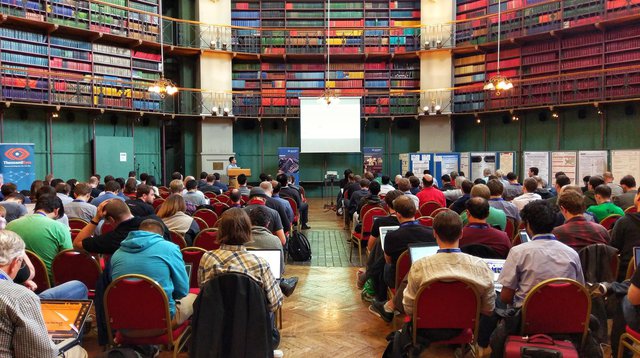This year's Internet Measurement Conference (IMC) was held in London from 1 - 3 November. In this article we highlight some of the presented work that we think is interesting and that the RIPE community might find useful.
The conference presented 28 long papers (each around 13 pages), 14 short papers (each around 6 pages), and 34 posters. In total, there were 193 registered attendees. IMC ranks as a key academic venue for presenting Internet measurement research, and the quality of the papers is generally very good. Many of the results provide interesting overviews that the operational or standards communities can use in their work.

Beautiful meeting venue: the octagon at the Queen Mary University of London
From the perspective of RIPE NCC:
- RIPE Atlas was used in at least half a dozen of the studies. The benefit of this for network operators is indirect; RIPE Atlas helps gain better insight into the Internet, how it interconnects and how things like DNS caching and anycast behave in the wild. Additionally, the measurement data collected with RIPE Atlas is open, and so the results can actually be re-used, corroborated, re-interpreted, and/or refuted.
- People seem well aware of RIPE efforts like RACI and the RIPE community projects fund as we got several questions about these. Still, it is hard to disseminate information (like the existence of these efforts) to the research community as a whole. We have not been able to find a single mailing list or other broadcast medium where we can effectively target academics interested in Internet measurement.
- A conference like this is also a place to meet other organisations running measurement infrastructures. An example is the MONROE project, which aims to measure cellular networks. Cellular networks are one of the types of networks that we don't cover so well with RIPE Atlas it will be interesting to compare deployment statistics between the projects, which is what we've started to do.
Paper Summaries
The quality of the papers presented was generally high! We've opted to not summarise the whole of the conference, but instead to cherry-pick the papers that stuck in our minds. All papers, their abstracts, and the presenter's slides are available online, but these are our picks:
- Cuba alternative Internet: A fascinating insight of how a network that is completely separate from the Internet developed in Havana, Cuba. There is some internet content (for instance a copy of Wikipedia that all can access). The network is self-censored, so it doesn't compete with the government-sanctioned network that has Internet connectivity. It's interesting to see how an alternative internetwork developed under different constraints then the global Internet (and as such it made us think a bit about TRON the movie...).
- Router Geolocation: In this work, publicly available IP geolocation services were tested for how well they work on router IP addresses. The takeaway was that such services don't work well on address ranges used for such infrastructure. Luckily our geolocation efforts (OpenIPMap and geo.ripe.net) are well underway to significantly improve infrastructure geolocation. We'll publish a follow-up on these efforts on RIPE Labs soon.
- IPv6 target generation: This work attempts to solve a problem presented to us by IPv6: how do we scan massive address spaces? Researchers are interested in this because they want broad datasets, but network operators ought to be interested in this because techniques such as these will become more commonplace as folks begin attempting to scan your networks on v6 as well as IPv4.
- Studying the Role of Cellular Networks: This takes a closer look at mobile networks in the modern ecosystem. This is one area where MONROE could complement Atlas in future measurements, by shining light on mobile infrastructure. Measuring from the perspective of Akamai's CDN, they highlight some of the disparities in global network deployments: around 26% of network traffic in Asian and African countries is mobile, compared to 12% in Europe. Further, they determine that almost half of the IPv6 traffic that they serve originates from mobile networks. Many networks are mixed, however, and 60% of the DNS resolvers identified are shared between fixed-line and cellular customers.
- Causes of Congestion on the African IXP substrate: This is a first study of congestion in the evolving African IXP market. They determined that most IXPs are congestion-free, which is to say they have provisioned well for their current customers and traffic levels; this hopefully promotes peering across the continent. The market is highly dynamic as it grows, so continued study will be useful.
- PacketLab is an idea about a measurement architecture where the measurement end points are simple packet reflectors, and the real logic of what packets to send or listen to rests somewhere else, namely in the infrastructure of the user running the specific experiment.
- An evaluation of QUIC, highlighting how it compares to TCP and also measuring how (un)fairly the two coexist.
Some of the research presented at IMC has been featured on RIPE Labs before, notably the research we were involved in on pinpointing delay and forwarding anomalies with RIPE Atlas, which we first published in May 2016.
If this eclectic summary of this conference leaves you interested in reading more, Ross Anderson at Cambridge took running notes, that we can recommended.
Final Notes
RIPE Atlas is now widely used by the measurement community, and the RIPE Routing Information Service (RIS) already was, and that's great: open data is one thing we ought to strive for, and RIPE NCC's management of the platform and data storage makes this feasible. What we arrive at, unfortunately, is the problem of discoverability: it is not common for papers to link directly to the measurements they ran, and/or show results that are directly actionable by network operators and others interested in the operational reality of the Internet. It would be an interesting discussion to see how RIPE and/or the RIPE NCC can help in this.
One other concern we have is that we understand that several (first) authors were unable to attend IMC due to US travel restrictions. This has always been an issue for some countries, but it was noticeable here given how much research is done in the USA, and how those people are being affected by new border restrictions. No papers were presented remotely at the conference, which feels like a missed opportunity. While there are significant tangible benefits to attending in-person, there are also legitimate constraints that exist for many people: visa restrictions, monetary costs, and the resource cost of traveling. These are known issues within the community, and we hope that future conferences will improve here.
As always, your thoughts on this article are appreciated, preferably as comments in the comments section below.





Comments 0
The comments section is closed for articles published more than a year ago. If you'd like to inform us of any issues, please contact us.